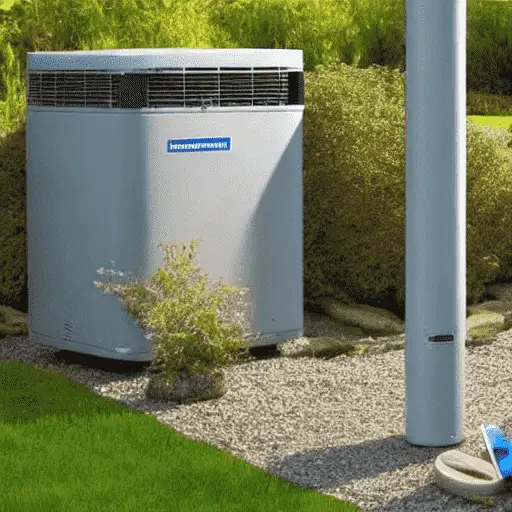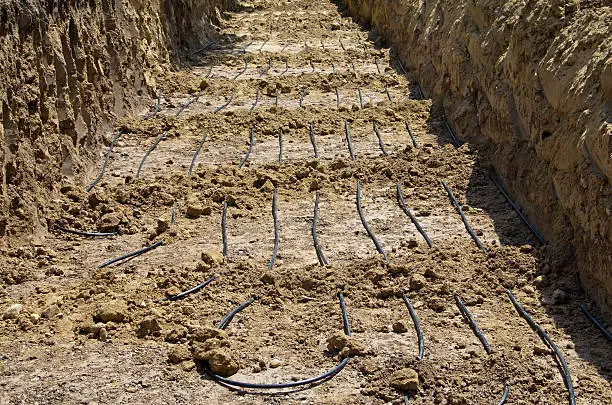A heat pump is a compression cycle refrigeration system that can be used for both heating and cooling a home. Performance, comfort and energy efficiency can all be affected by heat pump sizing and selection. So, what size heat pump does my house need? We look at that here.
Properties come in all shapes and sizes. Buildings of different ages built with different materials in a wide variety of environments. How do you know if the heat pump you are buying is right for your home? Thankfully, there are many different types of heat pumps available to suit almost every type of property.
What size heat pump do I need?
The size of the heat pump needed for a house depends on a number of factors, such as the size of the home, the climate, the number of occupants, and the home’s insulation. Typically the larger the property, the bigger the unit output required. A medium 5-7kW heat pump should be sufficient for a typical 3 bed semi-detached house.

When choosing a heat pump, it is important to select a unit that is the right size for the home. A heat pump that is too small will not be able to efficiently heat and cool the home. A heat pump that is too large will use more energy than necessary to heat and cool the house.
The best way to accurately know what size of heat pump your house needs is to get a professional to visit your property and do a full measurement of all the walls, windows, doors, radiators etc in the home. Then calculate the heat loss of your property before giving you the correct size.
But here, we’ll give you a guide of what goes into determining the size of heat pump.
Types of heat pumps
Heat pumps can be classified into three main types based on the source of heat they use: air source, ground source, and geothermal.
Air source heat pumps extract heat from the outside air and can be used for both heating and cooling a home. They are the most common type of heat pump and are suitable for most climates.
Ground source heat pumps extract heat from the ground or a body of water using a network of underground pipes. They are more expensive to install than air source heat pumps but are typically more efficient and have a longer lifespan.
Geothermal heat pumps use the constant temperature of the earth to heat and cool a home. They are the most efficient and longest-lasting type of heat pump but are also the most expensive to install.

What sizes do heat pumps come in?
| Heat pump size | Power Output in kW | House type |
|---|---|---|
| Small | 3kW | One bedroom flat/apartment |
| Medium | 5kW – 7kW | 3 bed semi-detached house |
| Large | 8kW – 11 kW+ | 4-5 bed detached house |
Air source heat pumps typically vary in power from 3kW to 15kW. The larger your home, the more kilowatts you’ll require. A 5kW heat pump is often required for a 3 bed semi-detached home, whereas at least an 11kW unit is required for a larger 5 bedroom detached house. A properly sized heat pump should be able to appropriately heat your home all year round.
A compact heat pump, generally weighs between 60kg and 80kg. A bigger heat pump, such as one weighs between 100 kg and 125 kg.
Sizing A Heat Pump
Sizing a heat pump involves determining the size of the unit needed to adequately heat and cool a home. A professional will take into account the size of the home, the climate, the number of occupants, and the home’s insulation to determine the size of heat pump needed.
The size of the heat pump is typically expressed in terms of its heating capacity, which is measured in BTUs (British Thermal Units) or kW (kilowatts). The larger the home, the more heating capacity is needed.
Types of Heat Pumps Available
Heat pump systems can be classified into three main types: split systems, hybrid systems, and ductless systems.
- Split systems consist of an outdoor unit that houses the compressor and an indoor unit that contains the air handler. They are the most common type of heat pump system and are suitable for most homes.
- Hybrid systems combine a heat pump with a traditional heating system, such as a gas furnace or boiler. They can switch between the two depending on the temperature outside and the demand for heat.
- Ductless systems, also known as mini-split systems, do not require ductwork to distribute heated or cooled air throughout the home. They consist of an outdoor unit and one or more indoor units that are mounted on the wall or ceiling.
What are the size dimensions of heat pumps?
Typical dimensions for heat pumps vary depending on the output, but the width and depth normally don’t change. It is the height of the unit that changes. Dimensions for heat pumps are normally around 1100 mm width, 450 mm depth. For height, ranges are 760mm for the small 3kW units up to 1600 mm for the larger 12kW output.
What can a heat pump replace?
The most common type of heat pump – air source heat pump, can replace the gas boiler currently in your home. It supplies hot water for the taps and will heat up the radiators around the property just like a boiler does.
Factors affecting heat pump size
The type of property
Dwellings are different and even with good insulation, a detached house with outside walls exposed on every side will leak out heat more than a terraced house. A mid terraced house is protected on either side by neighbours’ properties so they have to think about the lofts, doors and windows.
An apartment or flat may be the most protected if you have a flat above and below you as well as either side. People tend to keep their properties at roughly the same temperature.
Local climate
The climate plays an important role in choosing the size of heat pump required for a property. A smaller heat pump can be fitted in a warmer area since the temperature difference between the interior and exterior of the home is not as big.
If you live in an older property that is draughty and less well-insulated, you can still have a heat pump installed, but it will need to be bigger than the standard size.
A bigger heat pump is required in colder climates since the temperature differential between the inside and outside of the home is higher. But oversizing can cause issues with performance and lead to inefficiencies.
Number of occupants
The number of people in a home influences the size of the heat pump required. Because more heat is required within a residence with more people, a larger heat pump will be needed. There will also be more rooms which need to be heated.
Insulation level
The size of a heat pump required is also affected by the insulation of a property. Because more heat is lost through the walls, windows, and doors in a home with inadequate loft and hollow wall insulation, a bigger heat pump is required. Almost always, it’s advisable to get the property insulated before putting in a heat pump.

Benefits of installing a heat pump
Heat pumps have several benefits as a heating and cooling solution:
- They are more energy-efficient than traditional heating and cooling systems, especially in mild climates.
- They can provide both heating and cooling, making them a versatile choice for year-round comfort.
- They do not produce emissions, making them a cleaner and more environmentally-friendly option.
Disadvantages
However, heat pumps also have some drawbacks:
- They may not be as efficient as traditional systems in very cold climates.
- They are typically more expensive to install than traditional systems.
- They may require more maintenance than traditional systems.
What if I decide to keep my current heating system?
You may want to keep your existing gas or electric boiler as a backup, after installing a heat pump. The engineer must be able to determine the right size of the equipment in this scenario. Undersizing the heat pump taking into account existing systems may improve the efficiency.
It is important you make the installers aware of your heating habits and patterns and future plans, so they can fit the right size heat pump.
Read more about heat pump requirements here on the heat pump association website.
Read related articles:
